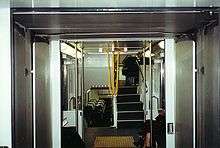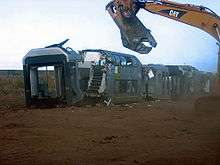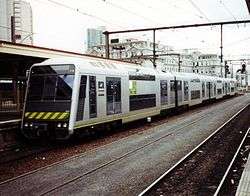4D Train
| Double-deck Prototype | |
|---|---|
|
4D train at Spencer Street | |
| In service | 1992-2002 |
| Manufacturer | A Goninan & Co |
| Built at | Broadmeadow |
| Family name | Tangara |
| Entered service | 10 March 1992 |
| Scrapped | 2006 |
| Number built | 4 |
| Formation | 4 carriages |
| Fleet numbers | 6000T-5000M-5002M-6002T |
| Capacity | 346 seated, 628 standing |
| Operator(s) | Public Transport Corporation |
| Depot(s) | Bayswater |
| Line(s) served | Belgrave, Lilydale |
| Specifications | |
| Car body construction | Stainless steel |
| Car length | 20.32 m (66 ft 8 in) |
| Width | 2.89 m (9 ft 6 in) |
| Height | 4.27 m (14 ft 0 in) |
| Doors | 4 twin-leaf plug doors per carriage |
| Articulated sections | 3 per set, enclosed gangway |
| Maximum speed | 130 km/h (81 mph) |
| Weight | 186 tonnes (183 long tons; 205 short tons) |
| Traction system | 8 x 170 kW (230 hp), chopper control |
| Acceleration | 0.75 m/s2 (2.5 ft/s2) |
| Power supply | (?) |
| Electric system(s) | 1500 V DC Overhead lines |
| Current collection method | Pantograph |
| Track gauge | 1,600 mm (5 ft 3 in) |
The 4D was a prototype double deck electric multiple unit built for the Public Transport Corporation, Victoria, for operation on the Melbourne railway system. It remains the only double deck train ever to have run in Melbourne.
Depending on sources, the intention was for this train to be the demonstration unit for a future order of either 20 or 50 extra sets, had the tests been successful.[1]
Design

Built by A Goninan & Co, Broadmeadow it was delivered by rail in December 1991.[2] Funding for the train was supplied from both the Victorian and Commonwealth governments.[1]
The train's design was based on the Tangara train being built by A Goninan & Co for CityRail in Sydney, however it was similar only in terms of interior and exterior bodywork; the train's electrical system was much closer to that of the Comeng sets. The design was further modified for use on Melbourne's broad gauge track, and its control system was designed specifically to allow in-service coupling and operation with Comeng sets.[3] In addition, the individual carriages were thinner and shorter in both length and width against their predecessors, to fit the Melbourne loading gauge. [1]
It was manufactured from stainless steel, fitted with air-conditioning, tinted windows, and inter-car doors allowing passengers to access all carriages of the train. Much of the equipment matched Sydney's Tangara fleet, from the traction motors (8x MB 3303B) down to small fittings like console buttons.[1]
The four-car set had a total passenger capacity of 974 passengers (346 seated and 628 standing); considerably more than a three-car Comeng train of similar length, which would only hold 763 passengers in crush load conditions, including 263 seated. However, the set had about the same seating capacity as a Tait train - 10 seats per compartment, 34 compartments per four-carriage set, with no data available on crush loads.
As part of the trial, the Belgrave and Lilydale lines were selected as main testing grounds for the unit and necessary works were performed to accommodate the train's somewhat unconventional dimensions. It was known that the train was physically too large for the Jolimont tunnel between Jolimont and West Richmond railway stations on the Hurstbridge and Epping lines. Given that the train was a demonstrator, it was likely that production designs or future infrastructure plans would have dealt with this.
By early 1993 the Victorian Government had decided not to proceed with the acquisition of any further double deck trains deciding infrastructure changes required to accommodate the larger trains were too expensive.[4]
Service
The unit broke from Melbourne tradition by being configured as Driving Trailer-Motor-Motor-Driving Trailer (D-TM-TM-D); all other sets in service at the time were (and are still) configured as Driving Motor-Trailer-Driving Motor (M-T-M). In a further break from tradition, the 4D did not use the 'D' code for a driving trailer, instead it was coded simply as T-M-M-T. The car numbers were also placed far outside the usual range; the 4D was numbered as 6000T-5000M-5002M-6002T.
Most of the time the 4D was on the rails it was parked in the stabling facilities at Bayswater on the Belgrave line.
It entered revenue service on 10 March 1992 after testing and a subsequent media launch.[3] Eight trips were scheduled for its first day in service, the first being the 08:36 service from Flinders Street to Box Hill, followed by the 09:08 return, on which the train suffered the first of its many failures. This required the train to be removed from service at Camberwell and the cancellation of the remaining trips.
Initially the 4D was run coupled to a 3-car Comeng set until 1996 when, after a troubled conversion to driver-only operation, it was permitted to operate on its own. Often as not, though, it was towed or pushed by a 3 or 6-car Comeng set following a failure.
When the suburban system was split into two in 1998 in preparation for privatisation, it was allocated to Hillside Trains, which became Connex.
Throughout its 10 years in Melbourne, the 4D continued to be plagued by reliability issues that saw it constantly in and out of service. After its disappointing entry to service, the train saw little use and was in storage by 1999. It was revived in June 2000, but lasted only a year.
A final attempt was made in February 2002 to return the set to service, but after three days it again failed and was placed back in storage, never to operate in revenue service again.[5][6]
Disposal

Ownership of the 4D was transferred back to the Victorian Government Department of Infrastructure, and the set was railed, ironically under its own power, to Newport Workshops in December 2002 for long-term storage.[7]
In 2006 the 4D was purchased by RailCorp for $168,000 [1] and stripped of parts compatible with the Tangaras.[8] On 29 March 2006 the 4D was transferred by El Zorro to metal recyclers Sims Metal, Brooklyn for scrapping.[9]
Railcorp had seriously considered converting the train to standard gauge, for exclusive use on shuttle services where structural modifications to add front and rear terminal doors would not have been needed. Unlike other New South Wales electrified rolling stock, the 4D would have been thin enough to operate through the Ten Tunnels on the Zig Zag route, which were built before John Bradfield introduced his wider loading gauge for the Sydney suburban system.[1] However, this plan collapsed on account of the conversion costs.
| Wikimedia Commons has media related to 4D (train). |
References
- 1 2 3 4 5 6 https://www.facebook.com/photo.php?fbid=3380889439405&set=a.1192189123265.2030430.1184504348&type=3&comment_id=10210023382839516&comment_tracking=%7B%22tn%22%3A%22R%22%7D
- ↑ "Interstate Rolling Stock" Railway Digest February 1992 page 73
- 1 2 4D train Vicsig
- ↑ "Melbourne abandons double deck plans" Railway Digest March 1993 page 84
- ↑ Vicsig photo: "The 4D lasted 3 days in service during 2002. It is shown here on a Blackburn to Flinders St service at Laburnum" - Friday, 22 February 2002
- ↑ Vicsig photo: "The 4D withdrawn and stored at Ringwood" 24 March 2002
- ↑ Vicsig photo: "The 4D in storage at Newport Workshops" - 14 December 2002
- ↑ Vicsig photo: "The 4D train being stripped of usable parts prior to scrapping at Newport Workshops" - 25 March 2006
- ↑ 4Ds last run Wongm's Rail Gallery
